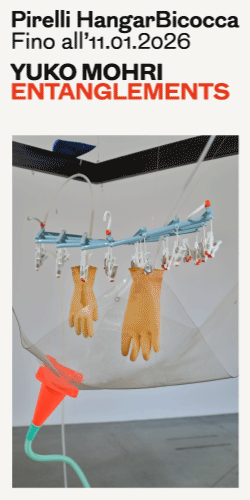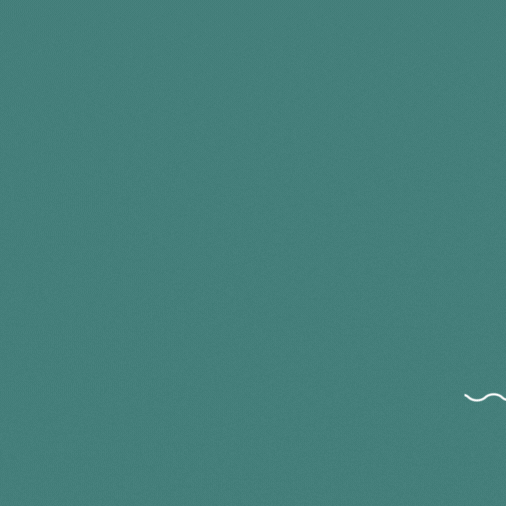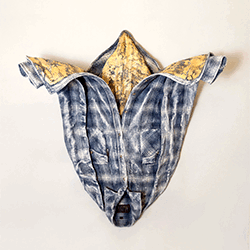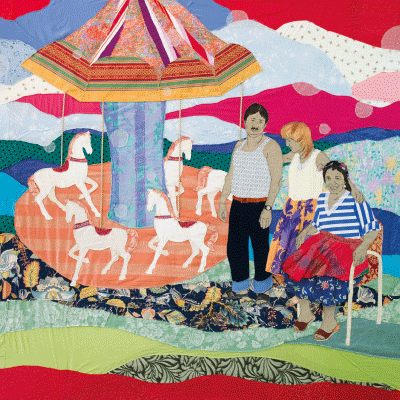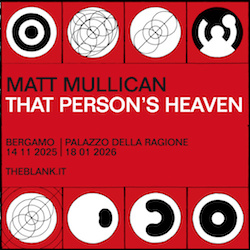
English text below —
Nei mesi di giugno e luglio State Of_, spazio dedicato all’arte contemporanea a Milano, ha invitato cinque artisti nel luogo virtuale della propria pagina Instagram per riflettere sulla ricontrattazione continua della sensazione di sicurezza online e offline e della loro reciproca influenza. Dopo le interviste con Nicholas Aloisio-Shearer, Kathi Schulz e Twee Whistler, abbiamo posto alcune domande a Theodore Darst.
Nei tre video presentati dall’artista a Digital (C)ode regna sovrano un senso di attesa che si imprime nella mente dello spettatore. Due layers di forme e moti contrastati sono sovrapposti e obbligati a interagire nelle loro totali estraneità. Imprigionate in loop monotoni e senza vie di fuga, le aspettative di chi guarda non giungono mai a soddisfazione. Cedono, invece, il posto a un sentimento di frustrazione e minaccia, come se dovesse accadere qualcosa da un momento all’altro. Si tratta però di campanelli d’allarme che risuonano a vuoto a causa di una spada di Damocle che forse non cadrà mai.
Marta Orsola Sironi: Attesa e frustrazione, minaccia e ordine compositivo: attraverso questi elementi sembri costruire il tuo rapporto con lo spettatore in un gioco di scarti e contrasti che non pare destinato a giungere ad alcuna soluzione. Come intendi il tuo rapporto con l’altro e con chi fruisce la tua opera?
Theodore Darst: Pensavo a Instagram come una piattaforma per guardare video. A come questo sia in tanti modi frustrante per sua natura. Mi piace far leva sulla frustrazione. Gran parte della composizione è conclusa ai tuoi occhi e tu rinunci a qualsiasi capacità di contestualizzare il lavoro a favore dei tuoi spettatori. Penso che il passaggio ai social media mi abbia fatto sentire sgomento quando ho fatto il progetto per Digital (C)ode, ma in un certo modo posso già sentire la mia attitudine volgersi proprio lì.
M.O.S.: Il senso di latente minaccia che si percepisce nei corti, può essere inteso come una denuncia di una condizione esistenziale, la nostra, ormai votata a navigare in acque solo apparentemente tranquille?
T.D.: Penso che la minaccia sia reale e sempre presente in questi giorni e che le acque non siano calme.
M.O.S.: La recente esperienza globale della pandemia ha influito sulla tua visione della realtà?
T.D.: Sì completamente. Prima della pandemia soffrivo all’idea che gran parte della mia vita e del lavoro che ho creato fossero più o meno insignificanti e frivoli. Ora ne sono completamente certo. La mia realtà è stata sostituita e ora ambisco a molto meno.
M.O.S.: In Contemplation, si scorge la sagoma di un poliziotto americano: i fatti di cronaca internazionale e le manifestazioni “Black Lives Matter” hanno riportato ancora di più in evidenza la precarietà e la violenza di cui la nostra contemporaneità è intrisa. Di fronte a questa insicurezza generalizzata, quale è il compito dell’arte, se un compito può averlo? Un possibile veicolo di denuncia sociale, uno strumento di riscossa o una via alternativa lungo la quale fuggire da tutto, magari nella dimensione virtuale?
T.D.: Dove vivo a Manhattan, vicino a molti edifici governativi, c’è una presenza quasi costante della polizia. Durante le proteste del BLM le unità di polizia sono state aumentate in modo assurdo. C’erano solo poliziotti ovunque. Tanti poliziotti quanti manifestanti. Filmo ciò che mi circonda. In quel momento mettere una di queste persone in un video aveva senso per me. Ho scoperto che la presenza costante della polizia ha un modo tutto suo per imprimersi nella mente.
M.O.S.: Le scale dell’ultimo video sembrano sottendere a un tentativo, o a un desiderio, di andare oltre la superficie, dentro i misteri dell’immagine. Tale moto vorticoso, che sembra trascinare lo sguardo dello spettatore con sé, si scontra inevitabilmente con l’inclemenza del pavimento alla fine della discesa. E’ un modo per dire che questo anelito al superamento delle barriere che sussistono tra fruizione e creazione del senso è in fin dei conti impossibile?
T.D.: Ero più interessato al design americano tradizionale. La comunità Shaker, ad esempio, non permetteva alle persone di avere figli, quindi inevitabilmente si sarebbero “estinti”. Stavo pensando a questa come un’approprioata metafora della vita. Inoltre, vado matto per una bella scala a chiocciola.
M.O.S.: Secondo la tua opinione, che ruolo ha la tecnologia nell’apertura di nuove possibilità creative?
T.D.: Penso che la tecnologia giochi un ruolo in tutto. Potrei ancora apprezzare un dipinto o una scultura, ma fondamentalmente sono eccitato dalla tecnologia, in particolare dalle nuove forme di approccio video. Quando guardo a come un artista si confronta con un paesaggio, andando oltre e superandolo, penso che quello sia il luogo in cui voglio essere.
A conversation with Theodore Darst
In the months of June and July, State Of__, a space dedicated to contemporary art in Milan, invited five artists to the virtual place of its Instagram profile to reflect on the continuous re-negotiation of the feeling of security online and offline and their mutual influence. After the interviews with Nicholas Aloisio-Shearer, Kathi Schulz and Twee Whistler, we asked Theodore Darst a few questions.
In the three videos presented by Theodore Darst for Digital (C)ode there is a sense of expectation that is imprinted on the viewer’s mind. Two layers of contrasted forms and motions are superimposed and forced to interact in their total otherness. Trapped in these monotonous loops with no escape routes, the expectations of the beholder never reach satisfaction. Instead, they generate a feeling of frustration and threat, as if something were to happen at any moment. However, these are alarms that sound in vain due to a sword of Damocles that perhaps will never fall.
M.O.S.: Expectation and frustration, a feeling of threat and compositional order: through these elements you build your relationship with the viewer in a game of differences and contrasts that does not seem destined to arrive at any solution. How do you think about your relationship with each other?
T.D.: I was thinking about Instagram as a platform to watch videos. How it is inherently frustrating in many ways. I like leaning into the frustration. So much of the composition is done for you and you relinquish any ability to contextualize the work for your viewers. I think the shift to social media had me feeling dismayed when I made the work for Digital (C)ode, but I can already feel my attitude shifting there in some ways.
M.O.S.: Is the sense of latent threat that is perceived in the videos a denunciation of our existential condition, which is now devoted to navigating in waters that are only apparently calm?
T.D.: I think the threat is real and ever present these days and the waters are not calm.
M.O.S.: Has the recent global experience of the health pandemic affected your view of the reality?
T.D.: Yes completely. Before the pandemic, I had been suffering from the notion that much of my life and the work I’ve created was more or less insignificant and frivolous. Now, I feel completely sure of this. My reality has been replaced and I want for much less now.
M.O.S.: In Contemplation, it is possible to see the silhouette of an American police officer: the events of international news and the “Black Lives Matter” demonstrations have brought even more evidence to the precariousness and violence of our contemporaneity. Faced with this generalized insecurity, what is the task of art, if art can have a task: a possible vehicle for social denunciation, an instrument of redemption or an alternative way along which to escape from everything, perhaps in the virtual dimension?
T.D.: Where I live in Manhattan, near many government buildings, there is almost constant police presence. During the BLM protests, the police presence was increased to an absurd amount. Just cops everywhere. As many cops as protestors. I film what is around me. To put one of these people in a video made sense to me at the time. The constant police presence has a way of staying in your mind I discovered.
M.O.S.: The scales of the last video seem to underlie an attempt, or a desire, to go beyond the surface, into the mysteries of the image. This swirling motion, which seems to drag the viewer’s gaze with it, inevitably collides with the inclemency of the floor at the end of the descent. Is it a way of saying that this yearning to overcome the barriers that exist between fruition and creation of meaning is ultimately impossible?
T.D.: I was more interested in traditional American design. The Shaker community didn’t permit people to have children so they would inevitably go ‘extinct’. I was thinking about this as a nice metaphor for life. Also, I love a spiral staircase.
M.O.S.: In your opinion, what role does technology play in opening up new creative possibilities?
T.D.: I think technology plays a role in everything. I still might like a painting or sculpture but I’m basically excited by technology, in particular new forms of approaching video. When I look at the landscape faced by artist’s moving forward that is the place where I want to be.



